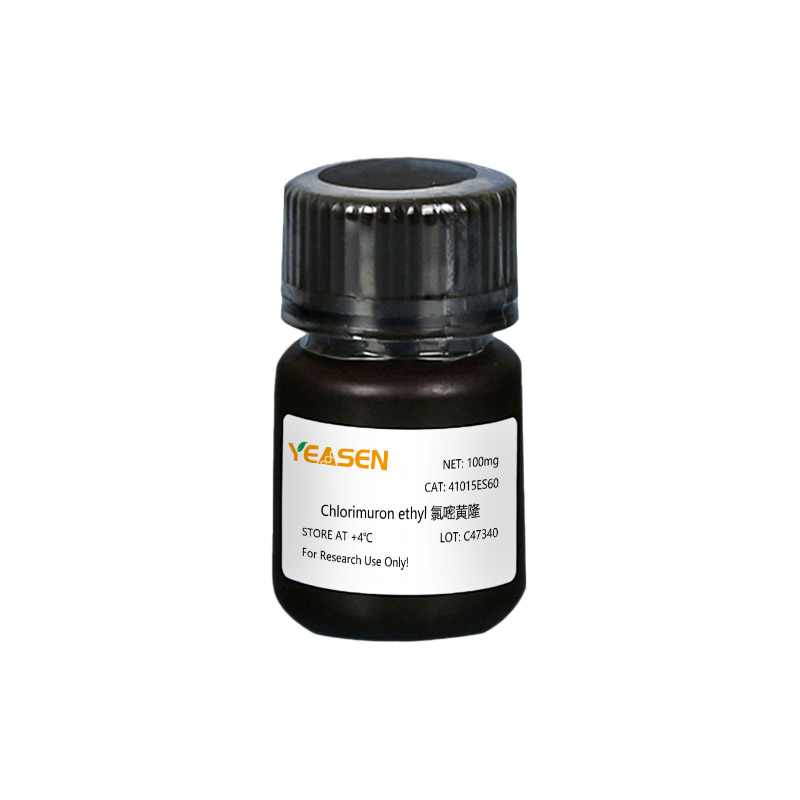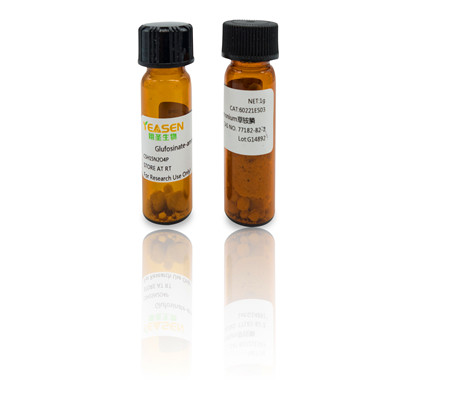HisSep Ni-NTA Agarose Resin (His标签蛋白琼脂糖纯化树脂)
产品货号
产品规格
是否有现货
价格
下单数量
操作
20502ES10
10mL
现货
¥ 648.00
20502ES50
50mL
现货
¥ 2708.00
20502ES60
100 mL
现货
¥ 5328.00
20502ES80
2x500 mL
预计 2~3周 发货
¥ 42686.00
产品详情
FAQ
产品文档
已发表文献
相关应用
相关产品
产品详情
产品介绍
HisSep Ni-NTA Agarose Resin以交联的6%琼脂糖凝胶为基质,通过化学方法偶联四配位的氮川三乙酸(NTA)为配体,螯合镍离子(Ni2+)后,形成非常稳定的八面体结构,镍离子处于八面体的中心,这样的结构可保护镍离子免受小分子的进攻,更加稳定,可以耐受一定浓度的还原剂、变性剂或耦合剂等苛刻条件。已经成为实验室纯化His标签蛋白不可或缺的树脂之一。
翌圣为您提供蛋白纯化实验整体解决方案,相关产品选购请参考:蛋白纯化系列产品-选购指南
产品性质
产品特色
| 基质(Matrix) | 交联的6%琼脂糖凝胶 |
| 粒径(Bead size) | 45-165 µm |
| 载量(Capacity) | >40 mg 6×His-tagged protein/mL 基质 |
| 耐压(Tolerance Pressuremax) | 0.1 MPa, 1 bar |
| 储存缓冲液(Buffer) | 含20%乙醇的1×PBS |
存储条件
2~8℃保存,有效期2年。
FAQ
Q:柱子反压过高是什么原因?
A:填料可能被堵塞:裂解液中可能含微小的固体颗粒,建议上柱前使用滤膜(0.22µm 或 0.45µm)过滤,或离心去除。
Q:为什么洗脱组分中无目的蛋白?
A:蛋白可能是包涵体:可通过电泳检测裂解液,分析上清中是否有目的蛋白,包涵体蛋白需按照包涵体蛋白的纯化方式;
Q:洗脱组分不纯(含多种蛋白)是什么原因?
A: 样品中含有其他 His 标签蛋白:通过调节 pH 值或咪唑浓度来优化洗杂条件。再使用其他纯化手段(如去离子交换,疏水等)进一步纯化洗脱组分。
Q:为什么填料颜色会变浅或变成白色?
A:镍离子脱落或者剥离,按照填料再生的操作重新挂镍离子。
Q:产品规格的体积指的是什么?
A:指的是填料的体积,不包括保护液的。
Q:填料流速慢的原因?
A:1.柱子在清洗平衡步骤流速减慢,柱子下筛板堵塞或者是试剂中有杂质堵塞。2.上样过程中流速逐渐降低,样品中有不溶物 堵塞填料或者是样品粘稠。少数情况蛋白挂柱后 流速也会减慢。 3.洗杂洗脱步骤流速减慢,蛋白不稳定 在柱子上沉淀,可以选择低温条件纯化,或者是在整个纯化过程中样品试剂中加入甘油保护蛋白。
产品文档
COA
已发表文献
- Cui Q, Bi H, Lv Z, et al. Diverse CMT2 neuropathies are linked to aberrant G3BP interactions in stress granules. Cell. 2023;186(4):803-820.e25. doi:10.1016/j.cell.2022.12.046(IF:64.5)
- Xia B, Shen X, He Y, et al. SARS-CoV-2 envelope protein causes acute respiratory distress syndrome (ARDS)-like pathological damages and constitutes an antiviral target. Cell Res. 2021;31(8):847-860. doi:10.1038/s41422-021-00519-4(IF:25.617)
- Deng X, Xiao Y, Tang X, Liu B, Lin H. Arabidopsis α-Aurora kinase plays a role in cytokinesis through regulating MAP65-3 association with microtubules at phragmoplast midzone. Nat Commun. 2024;15(1):3779. Published 2024 May 6. doi:10.1038/s41467-024-48238-9(IF:16.6)
- Zhao S, Chen Y, Chen F, et al. Sas10 controls ribosome biogenesis by stabilizing Mpp10 and delivering the Mpp10-Imp3-Imp4 complex to nucleolus. Nucleic Acids Res. 2019;47(6):2996-3012. doi:10.1093/nar/gkz105(IF:11.147)
- Li S, Yang X, Huang H, et al. Arabidopsis ACYL-ACTIVATING ENZYME 9 (AAE9) encoding an isobutyl-CoA synthetase is a key factor connecting branched-chain amino acid catabolism with iso-branched wax biosynthesis. New Phytol. 2022;233(6):2458-2470. doi:10.1111/nph.17941(IF:10.152)
- Xie L, Yan T, Li L, et al. An HD-ZIP-MYB complex regulates glandular secretory trichome initiation in Artemisia annua. New Phytol. 2021;231(5):2050-2064. doi:10.1111/nph.17514(IF:10.152)
- Feng Y, Chen JJ, Xie NB, et al. Direct decarboxylation of ten-eleven translocation-produced 5-carboxylcytosine in mammalian genomes forms a new mechanism for active DNA demethylation. Chem Sci. 2021;12(34):11322-11329. Published 2021 Jul 21. doi:10.1039/d1sc02161c(IF:9.825)
- Li X, Sun D, Feng H, et al. Efficient arsenate reduction in As-hyperaccumulator Pteris vittata are mediated by novel arsenate reductases PvHAC1 and PvHAC2. J Hazard Mater. 2020;399:122895. doi:10.1016/j.jhazmat.2020.122895(IF:9.038)
- Liu ZH, Xu HL, Han GW, et al. Self-Assembling Nanovaccine Enhances Protective Efficacy Against CSFV in Pigs. Front Immunol. 2021;12:689187. Published 2021 Jul 21. doi:10.3389/fimmu.2021.689187(IF:7.561)
- Xie L, Yan T, Li L, et al. The WRKY transcription factor AaGSW2 promotes glandular trichome initiation in Artemisia annua. J Exp Bot. 2021;72(5):1691-1701. doi:10.1093/jxb/eraa523(IF:6.992)
- Shu C, Wang L, Zou C, et al. Function of Foxl2 and Dmrt1 proteins during gonadal differentiation in the olive flounder Paralichthys olivaceus [published online ahead of print, 2022 Jun 16]. Int J Biol Macromol. 2022;215:141-154. doi:10.1016/j.ijbiomac.2022.06.098(IF:6.953)
- Chen T, Li Y, Xie L, et al. AaWRKY17, a positive regulator of artemisinin biosynthesis, is involved in resistance to Pseudomonas syringae in Artemisia annua. Hortic Res. 2021;8(1):217. Published 2021 Oct 1. doi:10.1038/s41438-021-00652-6(IF:6.793)
- Lu Y, Liu ZH, Li YX, Xu HL, Fang WH, He F. Targeted Delivery of Nanovaccine to Dendritic Cells via DC-Binding Peptides Induces Potent Antiviral Immunity in vivo. Int J Nanomedicine. 2022;17:1593-1608. Published 2022 Apr 5. doi:10.2147/IJN.S357462(IF:6.400)
购物车
客服
电话
咨询




